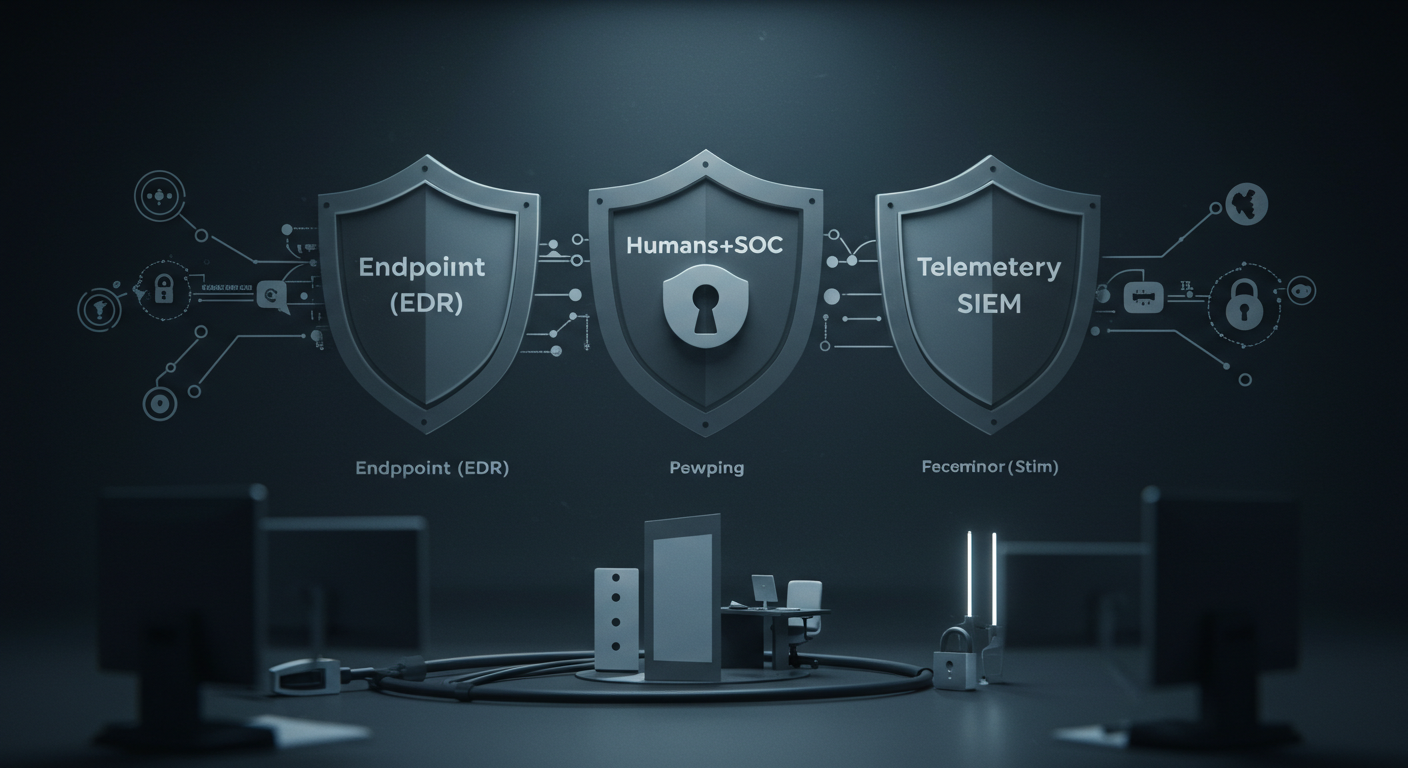
Ransomware Defense on a Budget: EDR vs. MDR vs. SIEM
Ransomware Defense on a Budget: EDR vs. MDR vs. SIEM
Ransomware isn’t just a line item in a risk register anymore; it’s a business model run by organized groups who automate the parts that used to require skill. They don’t care whether you have fifty laptops or five thousand, whether you run a lean IT team or a small MSP. They care about one thing: how quickly they can turn your access into their money. That’s why the “what should we actually buy” question matters. You can spend heavily and still leave gaps, or you can assemble a right-sized stack that punches above its weight.
This guide is a practical tour of three security pillars most buyers wrestle with—EDR, MDR, and SIEM—and how to combine them for real ransomware resistance without blowing your budget. We’ll demystify the acronyms, map each one to the ransomware kill chain, show trade-offs in money and staffing, and give you a 90-day rollout you can actually deliver.
First principles that save money and pain
Before we name tools, fix the posture. Ransomware succeeds when identity is soft, email is noisy, backups are breakable, and endpoints run anything they download. The cheapest and most effective mitigations are boring: strong MFA everywhere, patching that actually closes high-risk holes, application control for scripts and macros, least-privilege admin, and tested offline/immutable backups. These aren’t “nice to haves.” They are the soil your security tools grow in. If the soil is bad, nothing else thrives.
ALSO, READ WordPress Hardening on cPanel/WHM: Complete Security Guide
With those guardrails in mind, we can talk about detection and response—the domain of EDR, MDR, and SIEM.
What these acronyms really mean in practice
An acronym is only helpful if it predicts real outcomes. Here’s what each of these actually does for you day to day.
Endpoint Detection & Response (EDR) is a sensor and brain on your laptops and servers. It watches processes, memory, registry, scripts, and network connections on the host. When something looks like malicious behavior—credential dumping with Mimikatz, suspicious PowerShell, mass file encryption attempts—it blocks or kills the process, quarantines the file, and records everything so you can investigate. EDR is fast because it’s close to the action. It’s also honest about its scope: if it isn’t running on a device, that device is largely invisible.
Managed Detection & Response (MDR) is people plus a platform. You outsource the “eyes on glass” to a provider who monitors your telemetry 24/7, hunts for threats, triages alerts, and guides or performs containment. Some MDRs sit on top of your EDR; others bring their agent and portal. The value is time and expertise: they see weird patterns across many customers and respond at 2 a.m. when your two-person IT team is asleep. The catch is determining the split of responsibilities, the speed and authority of containment, and the hidden costs if you ask them to ingest more data sources later.
ALSO, READ Design Systems for WordPress: Tokens + Tailwind + Gutenberg
Security Information & Event Management (SIEM) collects logs from many places—identity (MFA, sign-ins), endpoints, servers, firewalls, SaaS apps—and lets you search, correlate, alert, and retain those records. SIEM helps you see beyond one endpoint: it’s how you notice that the service account created a new admin at midnight, that a domain controller emitted a suspicious event shortly before your EDR killed a process, or that a VPN tunnel popped up from an unexpected country. SIEM is also where costs creep in (log volume, storage retention) and where staffing requirements bite (somebody has to write, tune, and maintain detections so it’s not just a data lake).
A few related terms you’ll hear: XDR extends EDR by fusing telemetry from endpoints, identity, email, and cloud apps into one detection layer; NDR does similar for network traffic; SOAR automates response. They’re useful, but you don’t need to chase labels. Focus on capability: can you see the bad thing, can you decide quickly, and can you do something about it before files are encrypted?
Map tools to the ransomware kill chain
It helps to picture how a real incident unfolds. A typical ransomware run follows a pattern: initial access through phish or exposed service; foothold via malware or malicious OAuth; privilege escalation and credential theft; lateral movement toward file servers and domain controllers; discovery and staging; data exfiltration; encryption and extortion.
Now map your controls:
- Identity/MFA blocks many initial access attempts and slows privilege escalation.
- Email and web filtering remove commodity phish and malware before humans see them.
- EDR stops the foothold from turning into a wildfire by killing processes, monitoring scripts, spotting credential dumping, and isolating hosts.
- MDR collapses your response time by noticing a pattern across multiple endpoints and acting when you don’t.
- SIEM gives you wide-angle context: the same user failed MFA from three countries; a service account changed a GPO; three machines reached a known exfil domain. It’s also your investigation time machine and, for many, a compliance box ticked.
- Backups with immutability and tested restores break the extortion script. If you can recover quickly, the attacker’s leverage collapses.
The lesson is not “buy everything.” It’s “sequence buys so each new capability closes a gap in this chain.”
The hidden costs that derail SMB and mid-market teams
Budget buyers usually focus on license price per endpoint or per gigabyte. Three other costs matter more.
The first is people hours. EDR “without humans” still needs someone to approve isolates, tune false positives, push agent updates, and triage weekly activity. MDR reduces that load, but you must manage the vendor, handle escalations, and coordinate response. SIEM consumes the most hours if you build content yourself; detections rot without gardeners.
The second is tuning debt. Out-of-the-box rules are designed to be quiet. They won’t detect the bespoke ways your admins manage servers or how your ERP behaves. If no one tunes, you either drown in noise or miss things. Both are expensive in different ways.
ALSO, READ Entity SEO & Topical Authority: 90-Day Plan
The third is integrations and data gravity. Once logs flow into a SIEM or an MDR portal, switching gets harder. You can avoid lock-in by preferring vendors with open APIs, preserving raw logs in your own storage tier if possible, and writing down your detection logic in plain language so you can port it later.
Being honest about these costs early helps you pick a path you can actually walk.
EDR, MDR, SIEM—what to deploy at different sizes
There isn’t one correct stack, but there are patterns that work well for common stages.
For 10–50 employees with a lean IT staff or an MSP, the best return usually comes from strong identity and email hygiene, plus EDR with light MDR. EDR gives you on-host prevention and visibility; MDR gives you a 24/7 backstop so an after-hours alert doesn’t turn into a Monday-morning outage. SIEM at this size is often overkill unless you have a regulatory driver or highly fragmented SaaS that needs central visibility.
For 50–250 employees with one to three IT staff, outcomes improve markedly with EDR + MDR as your core, then a narrow SIEM or XDR layer focused on identity and admin activities (MFA anomalies, privilege changes, service accounts). You don’t need to ingest everything; pick log sources that matter to ransomware and identity compromise and keep retention pragmatic. This hybrid gives you deep endpoint control and just enough cross-signal to catch lateral patterns.
For 250–1,000 employees with an internal security lead, EDR + MDR is still a strong base, but a cloud-native SIEM becomes valuable for investigations, long-tail detections, and regulatory auditability. The key is discipline: constrain ingestion to high-value sources (identity, endpoint, core infrastructure, key SaaS like email and file storage), set specific retention periods, and budget time for tuning. If you can staff 0.5–1 FTE for content and response coordination, SIEM repays the investment.
Across all sizes, prioritize two qualities: speed to containment (how quickly can we isolate a host or revoke a token) and clarity of ownership (who does what at 2 a.m.). Tools are sidekicks; outcomes come from people and process.
A plain-English comparison that predicts outcomes
If you compare these options as if you’re picking a car, EDR is a reliable truck you drive yourself, MDR is a driver plus a fleet that shows up when you call, and SIEM is the highway camera network and traffic control room.
EDR shines when the incident is local and fast: a malicious process launches, the sensor recognizes it, kills it, and quarantines the file in milliseconds. You can hit a button to isolate the machine from the network while you figure out what happened. Ransomware crews who rely on noisy tools often die here.
MDR shines when the incident spans time and machines: three different users received a similar phish; one clicked; a second machine started doing unusual SMB traffic; your sign-in logs show an impossible travel pattern; the attacker tries a lateral move. People who look at patterns all day notice the shape quicker than a busy generalist can. They wake the right humans, they isolate hosts, and they hand you an incident summary instead of a mystery.
SIEM shines when questions span systems and weeks: “When did this service principal first ask for this scope?” “Which users created forwarding rules to external addresses last month?” “What else did this IP touch?” It’s also where you express your company’s unique risks in detection logic. But SIEM does nothing on its own. Without content and ownership, it is an expensive bucket.
On a tight budget, you want quick containment and always-on eyes first. That’s why EDR + MDR is the workhorse combination for many SMB and mid-market teams. Add SIEM when you can resource it and when the additional context improves decisions you actually make.
What “good EDR” looks like
A strong EDR agent earns its keep in four ways. First, it prevents common and modern attacks before they start: macro droppers, LOLBins abuse, script-based attacks, and known ransomware families. Second, when prevention can’t be certain, it detects and stops behavior decisively: mass file renames, encryption spikes, suspicious registry changes, credential dumping, and lateral movement tools. Third, it gives you one-click containment—isolate host, kill process, block hash—right from a clear timeline. Fourth, it plays well with others: it exports telemetry to your MDR or SIEM without games.
EDR deployment should be boring in the best sense. The agent goes on every Windows and macOS device (Linux where you have servers), it updates automatically, policies are staged in audit mode for a few days to catch legitimate scripts, and then prevention switches fully on. Weekly, someone reviews new detections and adjusts allow-lists sparingly. Monthly, you test isolation and rollback on a lab machine so the muscle memory is fresh.
The two biggest mistakes with EDR are coverage gaps and excessive exceptions. Gaps come from forgotten machines (labs, test rigs, new hires) and from service accounts or VDI pools you assume are safe. Exceptions creep in when someone adds a broad allow rule for “scripts” because one internal tool broke. Take pity on your future self: inventory endpoints weekly and review exceptions monthly.
What “good MDR” looks like
A mature MDR partner is unglamorous in the ways that matter: they are reachable, they are specific, they act. You should be able to answer five questions before you sign anything. What telemetry do they use—your EDR only, or do they also ingest identity, email, and SaaS logs? What do they do unilaterally versus what do they ask you to approve? What are their hours, escalation paths, and guaranteed response times? How do they hand off an incident to you—ticket, phone, dedicated chat—and what do those handoffs include? And finally, what do you really pay for—are there up-charges for more data sources, out-of-hours containment, or incident response time?
In a good MDR relationship, you agree on simple playbooks. If malware is executing on a user device, the MDR isolates it immediately and notifies you. If a new admin user appears on a domain controller at midnight, they call, and if they can’t reach you quickly, they trigger a pre-approved action (disable the account, block the source IP, revoke tokens). If a phish lands broadly, they search for clickers, reset credentials as needed, and send you a list of users for follow-up training.
ALSO, READ The 7-Block Homepage That Converts (With Wireframes)
What you avoid are vendors who send you raw alerts without triage, or who wait for your permission to act even for obvious, urgent cases. If your team is small, you’re paying them to reduce your night work and your decision load. Make sure the contract and the first month of operations reflect that.
What “good SIEM” looks like (and how to keep it from eating your budget)
If you go down the SIEM path, keep three words in your head: scoped, curated, useful. Scoped means you only ingest logs that support detections and investigations you will actually run: identity and MFA events, EDR alerts and telemetry, critical server and firewall logs, admin changes in cloud services, and a handful of high-value SaaS apps (email, file storage, SSO). Curated means you turn on content that maps to your risks (ransomware behaviors, suspicious inbox rules, anomalous admin activity) and disable or tune rules that don’t fit your world. Useful means every alert has a runbook and a person.
Start with outcomes. You want to catch and explain suspicious sign-ins, privilege escalations, lateral movement, unusual data egress, and signs of encryption or staging. That’s not everything a SIEM can do, but it’s the slice that pays for itself in ransomware defense. If you can’t staff detection engineering, prefer a SIEM or XDR that ships with strong, well-documented content for ransomware and identity, and a support model where someone helps you tune it quarterly.
ALSO, READ Zero-Click SEO in 2025: AI Overviews & Snippet Wins
Control spend by watching ingest volume and retention. Logging every packet for 365 days is a nice fantasy. Logging identity, EDR, and core infrastructure for 90 days is usually enough to investigate, satisfy auditors, and stay solvent. If your SIEM allows tiered storage, push older logs to cheaper archives and only rehydrate when needed.
The last mile is speed. A SIEM you can’t query at incident time is a museum. Make sure your team can search “what did this user do in the last 24 hours” or “which machines talked to this IP” in seconds, not minutes. Test it like you’d test a fire alarm.
Identity and email: the cheapest ransomware blockers you’ll ever deploy
Ransomware groups begin most journeys with a phish or a weak login. Two changes slash your risk before any fancy tooling: strong MFA with modern prompts, and email hygiene that removes obvious lures and punishes dangerous links. Enforce number-matching in authenticator apps; allow FIDO2 keys for power users; and remove legacy protocols that bypass MFA entirely. Configure anti-phishing and spoofing protections; set safe link rewriting; and make forwarding to personal mailboxes a reviewed exception, not a habit.
Teach people to report suspicious emails using the button in their mail client, and celebrate reports more than you shame clicks. You’ll never get to zero clicks, but you can make the second factor and your EDR rescue the day.
Backups and recovery: the business end of ransomware defense
A lot of buyers put backups under “IT operations,” not “security.” Attackers don’t. They look for backup agents and consoles, try to erase restore points, and delete snapshots. Move your backups into the heart of your security story. Aim for immutable copies (object lock, WORM), off-tenant copies (a separate provider or account that’s not in the same blast radius), and tested restores. Test means you actually bring up a small but meaningful slice of your environment from backups on a schedule. If you can restore quickly, you regain leverage.
Link backups to your EDR and MDR planning. If an endpoint is hit and the EDR catches it, you can recover local files. If a file server is hit, you flip to your snapshots. If the domain is messy, you work with your MDR or IR partner to prioritize restoration while you clean identity. None of this requires big spend; it requires clear decisions and practice.
A 30/60/90 plan that your team can deliver
First 30 days: posture and fast wins.
Inventory admin roles and cut to least privilege. Turn on strong MFA everywhere, with modern prompts and no legacy holes. Fix the easy email hygiene missteps—anti-phish, safe links, anti-spoof. Choose your EDR and start deployment in audit mode for a few days, then enable full prevention. Write down the isolate/contain playbook and test it on one sacrificial laptop. Verify your backups actually restore something that matters, not just a test file.
Days 31–60: deepen detection, add people, constrain sharing.
Finish EDR coverage across all user devices and servers. Decide if you will staff detection yourself or hire MDR; sign and integrate if you choose MDR. Switch EDR policies from “monitor” to “enforce” where you tested. If you have a SIEM or XDR, scope ingestion to identity, EDR, and core infrastructure and turn on high-value ransomware and identity rules with clear runbooks. Add simple rules in file shares to block write access from untrusted devices. If you collaborate externally, move sharing defaults to specific people with expirations. Run your first tabletop: a one-hour “what if encryption starts on a file server at 9:10 a.m.?”
Days 61–90: tune and prove.
Triage your first month of alerts with your MDR or your own team; quiet the noisy rules; raise the sensitive ones. Add one or two bespoke detections that match your environment (for example, alert if a new local admin is created on a domain controller, or if a script launches encryption tools in your VDI pool). Practice a partial restore from backups and time it. Publish a simple monthly brief to leadership: MFA coverage, EDR deployment %, number of prevented events, average time to isolate a host, and one story where the new posture avoided real pain.
If you go no further than this, you’re already far ahead of many peers.
Buying smart: questions that expose reality in demos
When you evaluate EDR, ask to see a live isolate of a test host, a process tree for a noisy kill, and a rollback of a simulated ransomware rename burst. Watch how many clicks it takes, how clear the timeline is, and whether a junior admin could follow along without a PhD in forensics. Ask how the agent behaves under patch Tuesday stress and how they prevent update failures from bricking a fleet.
When you evaluate MDR, ask about containment authority (“what can you do without me answering the phone?”), supported telemetry (EDR only or also identity and email), after-hours coverage, escalation paths, and included IR hours. Ask them to walk you through a recent real case end-to-end, including the exact messages they sent the customer and the timeline of actions. Vague answers are a red flag.
When you evaluate SIEM or XDR, bring two real questions from last quarter and ask the vendor to answer them in the product, with the clock running. “Show me every time a new local admin was created on any server in 30 days” or “Show me machines that reached out to this domain and what users were logged in at the time.” Time how long it takes to write the query, whether the result is readable, and whether you can pivot quickly to the next question.
These small tests surface big truths about usability and fitness.
Objections, myths, and better answers
One common objection is, “We can’t afford MDR.” Flip the frame: can you afford to be blind on weekends and holidays? If you have no one to respond at 3 a.m., a lightweight MDR that can isolate hosts and guide you saves more than it costs. You can start narrow—cover endpoints and identity—and expand later.
Another is, “EDR is enough.” It isn’t when the attack spans identities and cloud apps. EDR does heroic work on the device; it doesn’t tell you that a malicious OAuth app now reads the CEO’s mailbox. That’s why a sliver of identity visibility—via MDR, XDR, or a scoped SIEM—pays off.
A third is, “SIEM is for enterprises.” It’s true that a full-fat SIEM can eat your team alive. But a scoped, cloud-native SIEM or XDR used for a handful of high-value detections and investigations can be right-sized. The key is to keep ingestion disciplined and content focused, and to avoid pretending that “we’ll write detections later” is a plan. If you can’t staff it, buy a managed option or defer it.
What “done well” looks like in the real world
Picture an SMB manufacturer with 120 staff and a two-person IT team. They deploy EDR across laptops, shop-floor Windows machines, and a handful of Linux servers. They hire MDR that runs on top of that EDR and adds identity and email telemetry. Sharing defaults are tightened; link expirations live by default; external guests are allowed but monitored. Backups now include immutable object storage with a 14-day lock. Three weeks later, a phish sneaks through; a user clicks; the EDR kills a malicious process on the endpoint; the MDR isolates the host and resets the account; the SIEM (a small, managed one) notes an anomalous sign-in to a SaaS data store and the MDR revokes the token. The plant doesn’t stop. The monthly report shows one prevented incident and a faster isolation time than the last tabletop. Nobody high-fives; they get coffee and go back to work. That’s success.
Now picture a 600-person services company with an internal security lead. They run EDR, a co-managed MDR (vendor handles overnight and weekends; internal handles business hours), and a scoped SIEM that ingests identity, EDR, domain controllers, core SaaS, and firewalls. They added two custom detections around remote management tool misuse and new admin creation. Quarterly, they tune; monthly, they report; twice a year, they run a restore drill. When a ransomware affiliate tries RDP password spraying, the SIEM flags it, the MDR bans the source IPs, the EDR holds the line on endpoints, and nothing catches fire.
These stories aren’t fairy tales; they’re what happens when you choose capabilities that complement each other and you practice.
Executive summary for decision-makers
If you have to defend against ransomware on a budget, buy speed to act first. EDR gives you that on every endpoint; MDR gives you that when your humans are tired; SIEM gives you context when a question spans time and systems. Sequence your spend: identity and email hygiene first; EDR as your backbone; MDR as your multiplier; SIEM when you can feed and care for it. Bake backups into the plan as a security control, not an afterthought. Measure three things monthly: time to isolate a host, MFA coverage, and whether you can answer the question “what did this user do yesterday” in under a minute. If the answer is yes, you’re doing the right things.
A final word on culture
Tools don’t click “Isolate host.” People do. Your team’s calm confidence is the real control you’re buying when you simplify the stack and practice. Run short tabletops, write short runbooks, celebrate early reports, and keep changing a little every month. Attackers iterate. So can you—without spending like a giant.




